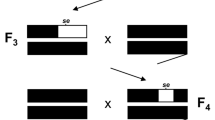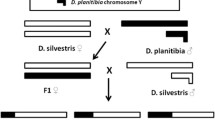Abstract
Understanding the origin of species is of interest to biologist in general and evolutionary biologist in particular. Hybrid male sterility (HMS) has been a focus in studies of speciation because sterility imposes a barrier to free gene flow between organisms, thus effectively isolating them as distinct species. In this review, I focus on the role of differential gene expression in HMS and speciation. Microarray and qPCR assays have established associations between misregulation of gene expression and sterility in hybrids between closely related species. These studies originally proposed disrupted expression of spermatogenesis genes as a causative of sterility. Alternatively, rapid genetic divergence of regulatory elements, particularly as they relate to the male sex (fast-male evolution), can drive the misregulation of sperm developmental genes in the absence of sterility. The use of fertile hybrids (both backcross and F1 progeny) as controls has lent support to this alternative explanation. Differences in gene expression between fertile and sterile hybrids can also be influenced by a pattern of faster evolution of the sex chromosome (fast-X evolution) than autosomes. In particular, it would be desirable to establish whether known X-chromosome sterility factors can act as trans-regulatory drivers of genome-wide patterns of misregulation. Genome-wide expression studies coupled with assays of proxies of sterility in F1 and BC progeny have identified candidate HMS genes but functional assays, and a better phenotypic characterization of sterility phenotypes, are needed to rigorously test how these genes might contribute to HMS.

Similar content being viewed by others
References
Assis R, Zhou Q, Bachtrog D (2012) Sex-biased transcriptome evolution in Drosophila. Genome Biol Evol 4:1189–1200
Barreau C, Benson E, Gudmannsdottir E, Newton F, White-Cooper H (2008) Post-meiotic transcription in Drosophila testes. Development 135:1897–1902
Bayes JJ, Malik HS (2009) Altered heterochromatin binding by a hybrid sterility protein in Drosophila sibling species. Science 326:1538–1541
Bock IR (1984) Interspecific hybridization in the genus Drosophila. In: Hecht MK, Wallace B, Prance GT (eds) Evolutionary biology, vol 18. Springer, US, pp 41–70
Catron DJ, Noor MA (2008) Gene expression disruptions of organism versus organ in Drosophila species hybrids. PLoS One 3:e3009
Charlesworth B, Coyne JA, Barton NH (1987) The relative rates of evolution of sex chromosomes and autosomes. Am Nat 130:113–146
Civetta A, Gaudreau C (2015) Hybrid male sterility between Drosophila willistoni species is caused by male failure to transfer sperm during copulation. BMC Evol Biol 15:75
Civetta A, Singh RS (1995) High divergence of reproductive tract proteins and their association with post zygotic reproductive isolation in Drosophila melanogaster and Drosophila virilis group species. J Mol Evol 41:1085–1095
Coulthart MB, Singh RS (1988) High level of divergence of male reproductive-tract proteins, between Drosophila melanogaster and its sibling species D. simulans. Mol Biol Evol 5:182–191
Coyne JA, Orr HA (1989a) Patterns of speciation in Drosophila. Evolution 43:362–381
Coyne JA, Orr HA (1989b) Two rules of speciation. In: Otte D, Endler J (eds) Speciation and its consequences. Sinauer Assoc, Sunderland, pp 180–207
Dean R, Harrison PW, Wright AE, Zimmer F, Mank JE (2015) Positive selection underlies faster-Z evolution of gene expression in birds. Mol Biol Evol 32:2646–2656
Dobzhansky T (1934) Studies on hybrid sterility. I. Spermatogenesis in pure and hybrid Drosophila pseudoobscura. Cell Tissue Res 21:169–223
Farré D, Roset R, Huerta M, Adsuara JE, Roselló L, Albà MM, Messeguer X (2003) Identification of patterns in biological sequences at the ALGGEN server: PROMO and MALGEN. Nucleic Acids Res 31:3651–3653
Ferguson J, Gomes S, Civetta A (2013) Rapid male-specific regulatory divergence and down regulation of spermatogenesis genes in Drosophila species hybrids. PLoS One 8:e61575
Garrigan D, Kingan SB, Geneva AJ, Vedanayagam JP, Presgraves DC (2014) Genome diversity and divergence in Drosophila mauritiana: multiple signatures of faster X evolution. Genome Biol Evol 6:2444–2458
Gomes S, Civetta A (2014) Misregulation of spermatogenesis genes in Drosophila hybrids is lineage-specific and driven by the combined effects of sterility and fast male regulatory divergence. J Evol Biol 27:1775–1783
Gomes S, Civetta A (2015) Hybrid male sterility and genome-wide misexpression of male reproductive proteases. Sci Rep 5:11976
Good JM, Dean MD, Nachman MW (2008) A complex genetic basis to X-linked hybrid male sterility between two species of house mice. Genetics 179:2213–2228
Gould-Somero M, Holland L (1974) The timing of RNA synthesis for spermiogenesis in organ cultures of Drosophila melanogaster testes. Roux Arch Dev Biol 174:133–148
Haerty W, Singh RS (2006) Gene regulation divergence is a major contributor to the evolution of Dobzhansky-Muller incompatibilities between species of Drosophila. Mol Biol Evol 23:1707–1714
Haerty W, Jagadeeshan S, Kulathinal RJ, Wong A, Ravi Ram K, Sirot LK, Levesque L, Artieri CG, Wolfner MF, Civetta A, Singh RS (2007) Evolution in the fast lane: rapidly evolving sex-related genes in Drosophila. Genetics 177:1321–1335
Haldane JBS (1922) Sex ratio and unisexual sterility in hybrid animals. J Genet 12:101–109
Harrison PW, Wright AE, Zimmer F, Dean R, Montgomery SH, Pointer MA, Mank JE (2015) Sexual selection drives evolution and rapid turnover of male gene expression. Proc Natl Acad Sci USA 112:4393–4398
Kitano J, Ross JA, Mori S, Kume M, Jones FC, Chan YF, Absher DM, Grimwood J, Schmutz J, Myers RM, Kingsley DM, Peichel CL (2009) A role for a neo-sex chromosome in stickleback speciation. Nature 461:1079–1083
Kulathinal R, Singh RS (1998) Cytological characterization of premeiotic versus postmeiotic defects producing hybrid male sterility among sibling species of the Drosophila melanogaster complex. Evolution 52:1067–1079
Lachaise D, David JR, Lemeunier F, Tsacas L, Ashburner M (1986) The reproductive relationships of Drosophila sechellia with D. mauritiana, D. simulans, and D. melanogaster from the Afrotropical region. Evolution 40:262–271
Lang M, Juan E (2010) Binding site number variation and high-affinity binding consensus of Myb-SANT-like transcription factor Adf-1 in Drosophilidae. Nucleic Acids Res 38:6404–6417
Llopart A (2012) The rapid evolution of X-linked male-biased gene expression and the large-X effect in Drosophila yakuba, D. santomea, and their hybrids. Mol Biol Evol 29:3873–3886
Ma D, Michalak P (2011) Ephemeral association between gene CG5762 and hybrid male sterility in Drosophila sibling species. J Mol Evol 73:181–187
Masly JP, Presgraves DC (2007) High-resolution genome-wide dissection of the two rules of speciation in Drosophila. PLoS Biol 5:e243
Meiklejohn CD, Parsch J, Ranz JM, Hartl DL (2003) Rapid evolution of male-biased gene expression in Drosophila. Proc Natl Acad Sci USA 100:9894–9899
Messeguer X, Escudero R, Farré D, Nuñez O, Martínez J, Albà MM (2002) PROMO: detection of known transcription regulatory elements using species-tailored searches. Bioinformatics 18:333–334
Michalak P, Ma D (2008) The acylphosphatase (Acyp) alleles associate with male hybrid sterility in Drosophila. Gene 416:61–65
Michalak P, Noor MA (2003) Genome-wide patterns of expression in Drosophila pure species and hybrid males. Mol Biol Evol 20:1070–1076
Michalak P, Noor MA (2004) Association of misexpression with sterility in hybrids of Drosophila simulans and D. mauritiana. J Mol Evol 59:277–282
Moehring AJ, Llopart A, Elwyn S, Coyne JA, Mackay TF (2006) The genetic basis of postzygotic reproductive isolation between Drosophila santomea and D. yakuba due to hybrid male sterility. Genetics 173:225–233
Moehring AJ, Teeter KC, Noor MA (2007) Genome-wide patterns of expression in Drosophila pure species and hybrid males. II. Examination of multiple-species hybridizations, platforms, and life cycle stages. Mol Biol Evol 24:137–145
Noor MA (2005) Patterns of evolution of genes disrupted in expression in Drosophila species hybrids. Genet Res 85:119–125
Oliveri G, Oliveri A (1965) Autoradiographic study of nucleic acid synthesis during spermatogenesis in Drosophila melanogaster. Mutat Res 2:366–380
Perez DE, Wu CI, Johnson NA, Wu ML (1993) Genetics of reproductive isolation in the Drosophila simulans clade: DNA-marker assisted mapping and characterization of a hybrid-male sterility gene, Odysseus (Ods). Genetics 134:261–275
Phadnis N, Orr HA (2009) A single gene causes both male sterility and segregation distortion in Drosophila hybrids. Science 323:376–378
Ranz JM, Castillo-Davis CI, Meiklejohn CD, Hartl DL (2003) Sex-dependent gene expression and evolution of the Drosophila transcriptome. Science 300:1742–1745
Sundararajan V, Civetta A (2011) Male sex interspecies divergence and down regulation of expression of spermatogenesis genes in Drosophila sterile hybrids. J Mol Evol 72:80–89
Tao Y, Chen S, Hartl DL, Laurie CC (2003) Genetic dissection of hybrid incompatibilities between Drosophila simulans and D. mauritiana. I. Differential accumulation of hybrid male sterility effects on the X and autosomes. Genetics 164:1383–1397
Ting CT, Tsaur SC, Wu ML, Wu CI (1998) A rapidly evolving homeobox at the site of a hybrid sterility gene. Science 282:1501–1504
Wu CI, Perez DE, Davis AW, Johnson NA, Cabot EL, Palopoli MF, Wu ML (1992) Molecular genetic studies of postmating reproductive isolation in Drosophila. In: Takahata N, Clark AG (eds) Molecular Paleo-population Biology. Springer, Berlin, pp 191–212
Zeng LW, Singh RS (1993) The genetic basis of Haldane’s rule and the nature of asymmetric hybrid male sterility among Drosophila simulans, Drosophila mauritiana and Drosophila sechellia. Genetics 134:251–260
Zhang Y, Sturgill D, Parisi M, Kumar S, Oliver B (2007) Constraint and turnover in sex-biased gene expression in the genus Drosophila. Nature 450:233–237
Acknowledgments
This work has been supported by an NSERC Discovery grant to AC.
Author information
Authors and Affiliations
Corresponding author
Rights and permissions
About this article
Cite this article
Civetta, A. Misregulation of Gene Expression and Sterility in Interspecies Hybrids: Causal Links and Alternative Hypotheses. J Mol Evol 82, 176–182 (2016). https://doi.org/10.1007/s00239-016-9734-z
Received:
Accepted:
Published:
Issue Date:
DOI: https://doi.org/10.1007/s00239-016-9734-z




